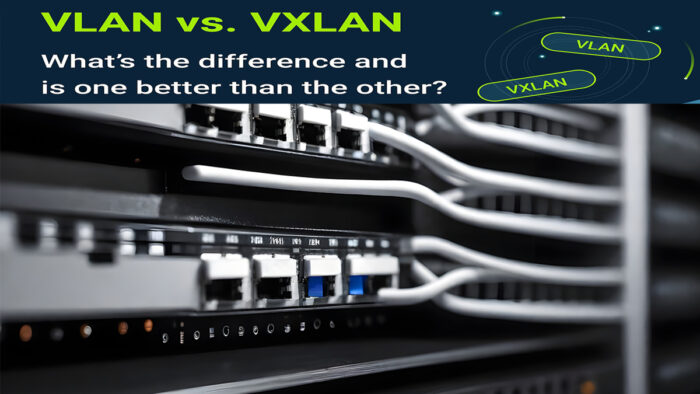Network segmentation plays an essential role in securing and managing modern IT infrastructures. In order to run datacenters well and deliver the best services to consumers, companies are trying to bring out premium performance from hardware. Two popular technologies, VXLAN and VLAN, help to improve networks effectively and contribute to improved security.

They are both technologies used to separate and organize network traffic. But you need to know that they work in different ways. In this guide, we will dive into what these two are, how they work, and the differences between them. Read to the very end to understand the difference between VXLAN and VLAN and how they can help you improve your network architecture.
What is VXLAN?
VXLAN is a network virtualization technology that is used to expand layer 2 network segments over a layer 3 network (IP network). This was brought up to help address the limitations of traditional VLANs in large data center areas. Just so you know, it is commonly used in cloud environments and data centers to create logical network overlays that can span more than one physical network segment. In general, VXLAN carries Layer 2 frames within Layer 3, which enables them to be transferred over an IP network.
It creates virtual networks over existing physical networks. It’s like building more floors in a building to accommodate more people without expanding the ground floor. VXLAN allows for greater scalability and flexibility, as it can support a much larger number of devices and network segments. It extends networks across multiple physical locations or data centers.
How Does it Work?
It works by stretching layer 2 networks across layer 3 infrastructure. This means it allows Ethernet traffic to travel over IP networks. You can think of it like packing a gift inside a box (an Ethernet frame) and then putting that box inside another box (a VXLAN packet). The outer box (header) contains important information, like the recipient’s address, which helps guide the gift to its destination.
When a server sends data, it’s like mailing a package from one address to another. The sender (VTEP) puts the package in the mailbox (tunnel), and the recipient (another VTEP) gets it from their mailbox. VTEPs can be physical devices or software running on servers, acting as the mail carriers that ensure the package reaches its intended destination safely.
What is a VLAN?
VLAN creates virtual networks within a LAN and lets you logically group devices together. In simple terms, it divides a single network into multiple virtual networks, allowing devices to communicate within their designated local area network. It’s like dividing a big classroom into smaller study groups, where each group can talk among themselves but not with others.
With it, you can easily create more than one network and broadcast the domains in small groups. And you can use this physical local area network to join together devices that communicate with each other frequently. For instance, instead of connecting your devices in the office under one single LAN or broadcast domain, you can create LANs for your HR department, marketing department, and finance department.
How Does it Work?
These switches create virtual groups within a single physical switch, where each group manages communication for a specific VLAN. You can set up ports on the physical switch to handle communication for each VLAN separately.
Additionally, these virtual groups can connect to others within the same network, even if they’re on different physical switches. Each VLAN requires a physical connection between switches to work.
Every data packet contains information in two parts. A layer 3 header with destination and source IP addresses, and a layer 2 header with MAC addresses. When data goes through these connections, a tag called the VLAN ID (VID) is added to the layer 2 header. It indicates the VLAN to which the data belongs.
This makes sure that the data packets only reach devices within their designated virtual LAN. The VID consists of a 12-bit field capable of creating 4096 IDs. But 0 and 4095 are reserved, allowing for up to 4094 VLANs on a single network.
VXLAN vs. VLAN: What’s the Difference?
VXLAN extends Layer 2 networks over Layer 3, enabling scalable and flexible network overlays, while VLAN partitions a single Layer 2 network into multiple isolated broadcast domains for traffic separation. For better understanding, we will summarize the differences between VXLAN and VLAN in a table. Check it out.
| Criteria | VLAN | VXLAN |
| Encapsulation | It does not use encapsulation. It solely relies on 802.1Q tagging | It makes use of UDP for transport and packet encapsulation |
| Management | This can be managed via VLANs aware switches | This requires a gateway for interconnecting physical and virtual networks |
| Scalability | It is limited to 4,096 virtual Local Area Networks | It support about sixteen million virtual networks |
| Network isolation | It offers isolation within the layer two network | It enables isolated layer two network over layer 2 boundaries |
| Broadcast Traffic Handling | The Broadcast traffic is circulated to all the Ports that is within the Virtual local area network | It makes use of unicast-based replication in order to increase the broadcast traffic. |
| Spanning Multiple Sites | This is limited to just one broadcast domain | It enables the extension of layer two networks over geographically dispersed areas. |
The proper process of VXLAN will require VXLAN-capable devices that support the encapsulation techniques and mandated protocols. Their networks can be made and managed with these devices. While VLANs are widely used and implemented in network infrastructure, because the majority of network devices support them without needing specialized support or hardware.
Which One Should I Choose?
The choice between these two will depend on your network infrastructure needs. Both of these technologies have their own considerations and advantages that you should take into account. . If you need a scalable solution that can work with a large number of network segments or virtual machines, you should go for VXLANs.
However, if your network has simple requirements and is scaled, VLANs can be the right option for you. Because they are well established and are supported widely in most of the network equipment.



